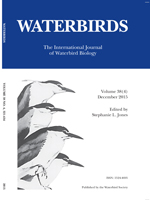Bird use of diked and undiked Michigan coastal wetlands (n = 17) was studied on Lake St. Clair and Lake Huron during late July to mid-October, 2005–2007. Relative abundance and diversity were compared via aerial (n = 9) and ground (n= 155) surveys and wetland characteristics were measured. Species richness and similarity indices suggested analogous bird use, but multivariate analyses indicated significant separation in diked and undiked bird assemblages. Wood Duck (Aix sponsa), Great Blue Heron (Ardea herodias), and Wilson's Snipe (Gallinago delicata) were more abundant on diked sites, whereas dabbling ducks combined, Mallard (Anas platyrhynchos), American Black Duck (A. rubripes), gulls (Laridae), Forster's Tern (Sterna forsteri), and Greater Yellowlegs (Tringa melanoleuca) were more abundant on undiked wetlands. Wetland characteristics also differed. Diked sites were primarily cattail (Typha spp.) marshes interspersed with small open-water areas containing aquatic plants. Undiked sites had larger openings fringed with bulrushes (Schoenoplectus spp.), fewer aquatic plants, and direct lake connections. Periodic drawdowns of diked wetlands could encourage greater plant species and structural diversity, making them more attractive to dabbling ducks. However, risk of common reed (Phragmites australis) expansion is high in the study areas, thus its control may be necessary before enhanced management can occur.
How to translate text using browser tools
1 December 2015
Post-Breeding and Early Migrant Bird Use and Characteristics of Diked and Undiked Coastal Wetlands in Michigan, USA
Michael J. Monfils,
Patrick W. Brown,
Daniel B. Hayes,
Gregory J. Soulliere
ACCESS THE FULL ARTICLE

Waterbirds
Vol. 38 • No. 4
December 2015
Vol. 38 • No. 4
December 2015
birds
coastal wetlands
diked
Great Lakes
Michigan
waterfowl




